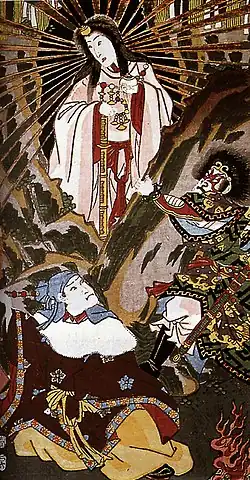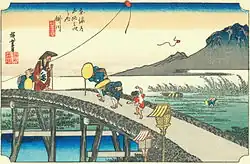Ryūtōsan Shrine
| Ryūtōsan Shrine | |
|---|---|
| Religion | |
| Affiliation | Shinto |
| Deity | Ōmononushi (Konpira Gongen) Kunitama Okami Amaterasu Okami |
| Year consecrated | 1678 |
| Location | |
| Geographic coordinates | 35°06′03″N 129°01′57″E / 35.1008°N 129.0325°E |
| Location relative to modern-day Busan | |
Ryūtōsan Shrine (龍頭山神社) was a Shinto shrine in Korea. It was the earliest shinto Shinto shrine built in Korea.[1]: 139
History
Originally named Kotohira shrine (金刀比羅神社), the shrine was built by workers of the local Japan House trade office in 1678.[2] Shinto shrines of this kind may have served the purpose of expressing and maintaining a Japanese identity outside of Japan, while the Japanese and Korean people lived relatively closely during this period.[3] it was later renamed Ryūtōsan Shrine (龍頭山神社, Ryūtōsan Jinja).[2]
The shrine was destroyed after the liberation of Korea. Its former site is now part of Yongdusan Park.
Enshrined deities
The shrine was a Kotohira shrine, dedicated to Ōmononushi and the protection of sailors.[2] In addition it, alongside all other nationally ranked shinto shrines in Korea, enshrined Amaterasu and Kunitama as a pair.[1]: 139
References
- ^ a b Shimizu, Karli; Rambelli, Fabio (2022-10-06). Overseas Shinto Shrines: Religion, Secularity and the Japanese Empire. London New York (N.Y.) Oxford: Bloomsbury Academic. ISBN 978-1-350-23498-7.
- ^ a b c Nakajima, Michio (2010). "Shinto Deities That Crossed the Sea: Japan's" Overseas Shrines," 1868 to 1945". Japanese Journal of Religious Studies. 37 (1): 21–46. JSTOR 27822898. Retrieved 31 January 2016.
- ^ Grisafi, John G. "Shintō in Colonial Korea: A Broadening Narrative of Imperial Era Shintō".
{{cite journal}}: Cite journal requires|journal=(help)

